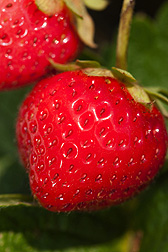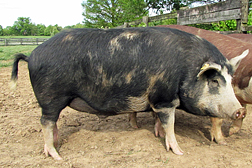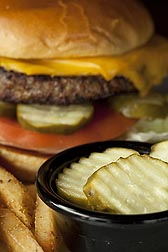| January 2015 |
Latest Update of USDA National Nutrient Database for Standard Reference ReleasedThe latest update of the U.S. Department of Agriculture (USDA) National Nutrient Database for Standard Reference, Release 27, is available. Each year, new food-nutrient profiles are added to the database, and existing nutrient profiles are updated using data generated by the Agricultural Research Service (ARS) through its National Food and Nutrient Analysis Program and collaborations with the food industry and with others. The Internet "dashboard" that users see after launching the online version of the database has been reorganized so that users can more easily select and view food-nutrient profiles from individual food groups. Another new consumer-oriented upgrade allows users to look up the amount of a specific nutrient within any one of the database's food items. For example, a person whose doctor recommends more dietary fiber might sort all foods by fiber content from highest to lowest. Containing data for more than 8,600 food items, the database is compiled by scientists at the ARS Beltsville Human Nutrition Research Center. For details, contact: David Haytowitz, (301) 504-0714, ARS Nutrient Data Laboratory, Beltsville Human Nutrition Research Center, Beltsville, Maryland. |
|
|
|
Scientists Scrutinize Role of "Supershedder" Cattle in E. coli O157:H7 ContaminationAbout 2 percent of the cattle grazing in a pasture or eating high-energy rations in a feedlot pen, on average, may be "supershedders" who shed high levels of pathogenic organisms such as Escherichia coli O157:H7 in their manure, according to new ARS research. The research was also the first to show that, in supershedders, O157 colonization may occur not just in the lower digestive tract but also throughout the supershedders' entire digestive system. Packinghouse managers can take that information into account when evaluating their facility's sanitation procedures. The research was also the first to determine that supershedding was not restricted to any particular O157 strain. This work rules out the idea that tactics designed to reduce supershedding should target a specific strain or strains. It also indicated that, in order for a cattle-management strategy to be deemed successful for reducing transmission of O157, no more than 20 percent of the cattle targeted by the intervention would be shedding the microbe at any one time, and none would be shedding it at supershedder quantities. For details, contact: Terrance M. Arthur, (402) 762-4227, Roman L. Hruska U.S. Meat Animal Research Center, Clay Center, Nebraska. |
Brain Images Focus on Stress Eaters' Neurological Response to Comfort FoodsAn ARS study has taken a close look at pathways inside the brain showing the links between stress and unhealthy eating or, technically speaking, the neurophysiology of stress eating. The study has shown that when high-stress volunteers viewed calorie-rich foods, activity in their prefrontal cortex, a region of the brain that regulates self-control and strategic decision-making, was essentially "turned off." This was in contrast to the response revealed in brain scans of the low-stress volunteers who were shown the same photos. For more than a decade, obesity researchers have used sophisticated neuroimaging technology to detect and map the way the brain responds to food. But Laugero's research, documented in a 2013 peer-reviewed scientific article in Physiology & Behavior, was unique and may help pave the way to science-based strategies that help stress eaters break the habit. For details, contact: Kevin Laugero, (530) 752-4173, Stress Biology and Nutrition Research Laboratory, Western Human Nutrition Research Center, Davis, California. |
|
|
|
New Test Counts Total Phenolics in Fruits and VeggiesA new analytical method for detecting and measuring concentrations of phytochemicals called "polyphenols" in plant materials has been devised by ARS scientists. The researchers first used the test, which involves mixing the food sample with Fast Blue BB diazonium salt, on a variety of beverages, grains and flaxseed. The team then compared the new Fast Blue BB method to results using a traditional assay called Folin-Ciocalteu (FC). The results suggested that FC does not assess all phenolics present during tests and inadvertently measures other compounds besides phenolics. While the Fast Blue BB method, as originally developed, was aimed at measuring phenolics only in plant tissue that does not contain chlorophyll, other ARS researchers reasoned that the test could also be modified to work with green vegetables. The test has now been used to gauge the amount of total phenolics in different spinach cultivars grown under different production conditions. For details, contact: Gene Lester, (301) 504-4616, ARS Office of National Programs, Beltsville, Maryland. |
Fun, Friendly Website Helps Teens Eat More VeggiesVideos featuring animated-cartoon teens learning about nutrition may help real-life teens eat more veggies, according to a study by scientists funded by ARS. The smart and sometimes funny cartoon teens appear in short videos that are part of the experimental, science-based "Teen Choice: Food and Fitness" website, which was developed to motivate adolescents to make better food choices and to be less sedentary. About 400 teen volunteers were asked to visit the site at least once a week for 8 weeks, peruse its information about food and nutrition, set a nutrition or fitness goal, and check their progress weekly. More of the volunteers who had access to the site's interactive features—including the cartoon videos and a blog—reported eating three or more servings of veggies in the past week than did volunteers whose access didn't include these and other interactive options. That's important, because getting kids to eat more veggies is apparently more difficult than getting them to eat more servings of fruit, for instance. For details, contact: Karen Cullen, (713) 798-6764, ARS Children's Nutrition Research Center, Houston, Texas. |
|
|
|
Protecting the Flavor of Mandarin OrangesARS scientists and their University of California-Riverside colleague are doing some of the most extensive research ever done on how storage temperatures and the amount of time in storage at packinghouses affect the flavor of various mandarin oranges. One of their experiments has shown that cold storage temperatures influence the flavor of the classic W. Murcott Afourer oranges, often referred to simply as W. Murcott mandarins, but not the flavor of the Owari variety. In other work, the researchers found that significant changes in several flavor-associated chemicals occurred soon after W. Murcott mandarins were brought out of cold storage. Significant increases in three chemicals (ethyl acetate, ethyl propanoate and ethyl 2-methylpropanoate) that belong to a class known as ethyl esters occurred within the first 24 hours after the mandarins were moved from 41-degree Fahrenheit storage into 68-degree Fahrenheit storage. Significant increases in a fourth ethyl ester, ethyl 2-methylbutanoate, took place a day later. All four ethyl esters are thought to contribute to a sweet, fruity aroma, which may have a role in what is perceived as flavor. However, it has been suggested that high levels of these four compounds may contribute to off-flavor. For details, contact: David M. Obenland, (559) 596-2801, Commodity Protection and Quality Research Unit, USDA-ARS San Joaquin Valley Agricultural Sciences Center, Parlier, California. |
Pig Breed Serves as Ideal Model for Human Obesity ResearchARS researchers and their collaborators have done a series of studies that show that the pig makes an excellent model for human obesity-related research and for studying metabolic effects induced by a high-fat diet. The Ossabaw pig was selected because it has a greater tendency than other pig breeds to deposit excess fat and develop obesity-related diseases when fed a high-calorie diet. The emphasis was on using juvenile pigs as a model for obesity in children. In general, it is difficult to evaluate obesity-related metabolic disturbances in children. The researchers found changes in lipid metabolites in all of the analyzed host tissue samples from the pigs fed the high-fat diet. Some tissue-dependent changes were not reflected in the biofluids. Being able to look at organ tissue helped researchers target changes that are indicative of both disease and poor response to diet. For details, contact: Gloria Solano-Aguilar, (301) 504-8068 ext. 295, Diet, Genomics and Immunology Laboratory, Beltsville Human Nutrition Research Center, Beltsville, Maryland. |
|
|
|
Orange-fleshed Honeydew: Ripe for Beta-carotene AnalysisOrange-fleshed honeydews were found to have significantly higher beta-carotene concentrations than cantaloupe, but the two melon types were found to have similar beta-carotene bioaccessibility. Orange-fleshed honeydew melons are a cross between cantaloupe and green-fleshed honeydew, but they are sweeter and store longer than the typical cantaloupe. They were also found to contain five apocarotenoids, which are metabolized directly into vitamin A. Previously, the researchers did not know that apocarotenoids were in orange-fleshed melons. For details, contact: Gene Lester, (301) 504-4616, ARS Office of National Programs, Beltsville, Maryland. |
Calcium Makes for an Environmentally Friendly PicklePickle producers are getting a helping hand from ARS researchers to turn an environmental problem into an environmental plus by replacing most of their production pickling salt with calcium chloride. The U.S. pickle industry has been facing growing environmental troubles with disposing of the salty brining solution used to turn cucumbers into pickles. Used calcium chloride solution can be a desirable soil amendment rather than a pollutant disposal problem. The technology has already been put to work commercially at the Mt. Olive Pickle Company of Mt. Olive, North Carolina. ARS researchers are also modifying the new calcium chloride technology as a way to preserve gherkin pickles that are imported in acid solution from India. Currently, gherkins undergo a 40-day Atlantic transit packed in vinegar, salt and sulfite; the last ingredient has come to be considered an undesirable ingredient, as some people are sensitive to it. Sulfite would not be needed with new brine formulation. For details, contact: Ilenys Perez-Diaz, (919) 513-0165, Food Science Research Unit, Raleigh, North Carolina. |
|
|
|
Delicious, Nutritious, and a Colorful Dish for the HolidaysThree nutritious new potato varieties with red and purple flesh and skin have been developed by ARS scientists and their cooperators and are now available to consumers. All potatoes contain an assortment of nutrients and other health-promoting compounds, but the team found that purple potatoes had a 20-fold greater concentration of anthocyanins than yellow potatoes. The new great-tasting potato varieties, TerraRosa, Amarosa and Purple Fiesta (also known as Purple Pelisse) perform well across a variety of preparation methods such as baking, roasting, microwaving, steaming and mashing. For details, contact: Charles Brown, (509) 786-9252, Fruit and Vegetable Insect Research, Prosser, Washington. |
Scientists Develop New Way to Make Food Ingredient from Rice Bran OilSome of today's popular baked goods could one day contain a butter-like extract derived from rice bran oil as a partial replacement for margarine, butter or shortening. ARS scientists at the National Center for Agricultural Utilization Research in Peoria, Illinois, developed a unique process for making the extract, which somewhat resembles a nut butter, using very low temperatures. Unlike some shortening and margarines, the extract is free of trans fats, is shelf-stable and resists oxidation that could otherwise result in off-flavors and unpleasant odors. It also contains minor amounts of vitamin E; plant sterols, including some that are of interest to medical and nutrition researchers because of their potentially health-imparting properties; and gamma-oryzanol, shown to lower levels of "bad" LDL cholesterol in humans. For details, contact: Erica L. Bakota, (309) 681-6057, Functional Foods Research Unit, National Center for Agricultural Utilization Research, Peoria, Illinois. |
|












